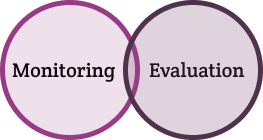
Have you ever put together a tracking sheet to keep a running count of the number of supplies you have given out, or used a sign-in sheet to capture the number of people who were present at an event? If so, you have engaged in a form of program monitoring. In essence, program monitoring is the routine collection of new or existing program data from tools such as databases, progress reports, and performance documents. It is typically done on an ongoing basis to better understand whether the program is operating as it should. When you regularly monitor your harm reduction program activities, you not only help your program stay organized, but also help ensure you have the information you need to make immediate program improvements and adjustments.
While the two practices overlap, program evaluation and program monitoring are two distinct activities.
(Table 1.2). The table below details some of the notable differences between the two approaches.
| Program Monitoring | Program Evaluation |
|---|---|
| Answers the question: “Are we doing things right?” | Answers the question: “Are we doing the right thing?” |
| Occurs on a routine basis | Occurs on a periodic basis |
| Focuses on input, activity, and program output | Focuses on outcomes, impact and overall goal of program |
| Provides information about the current status of program activity | Provides information about the overall impact of program activity |
So, where does research fit in? Research aims to uncover new knowledge, or promote existing knowledge, about a theory, practice, or behavior. For example, over 30 years of research has generated indisputable evidence that harm reduction interventions such as syringe services programs not only save lives, but are safe, effective, and play an important role in reducing the transmission of viral hepatitis, HIV, and other infections.
If you are interested in learning more about advances in harm reduction research as well as new and emerging research projects, visit the following sites: